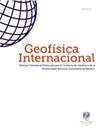墨西哥地震的矩张量目录:近二十年的地震活动
IF 0.7
4区 地球科学
Q4 GEOCHEMISTRY & GEOPHYSICS
引用次数: 6
摘要
为了获得2000-2018年全国报告的M≥4.0地震的力矩张量解,我们利用波形和SSN (Servicio Sismologico nacional)的目录分析了2万多起地震。由于事件的数量,本文提出了一个基于一组准则的自动过程,允许获得尽可能多的事件的力矩张量解。利用每个事件的震中位置和初步震级,确定了有效站的子集。应用于观测和合成地震记录的记录和滤波的最小长度是自动定义的。应用公式需要了解每个震颤-站对之间的绿色弹性函数。为了减少计算时间,使用了一个预计算的格林函数库。利用三个站组合的线性反演,利用观测数据和相应的格林函数确定地震力矩张量(各向同性部分为零)。为了最小化与所使用站点的线性分布相关的可能偏差,每个解都根据方位角覆盖进行加权。根据提出的自动过程,仅获得了8000次地震的解决方案;这是由于某些限制,如可用记录的大小和/或它们的完整性。解的质量是通过方差还原值(VR)来测量的。通过对质量的统计分析,我们可以将VR≥50%作为可靠解决方案的允许极限。根据这一标准,我们提出了一个包含1500个事件的目录,其中包括一些小事件(2000-2018年期间Mw = 4.0,目的是确定它们的力矩张量解)。由于事件数量众多,我们根据一套标准实现了流程的自动化。Using epicentral location and magnitude of每累计by the SSN, a set of valid地震成都to be for the巴拉克的solution, the length of time series, and the filter band for data and synthetics are automatically selected。To加快calculations pre-computed library of Green是用来履行职务。通过线性inversion, for three-station combinations, observed数据和对应的绿色职务是用来确定seismic巴拉克tensor (with null isotropic component)。为了减少与站分布有关的可能的偏置,每个解决方案都是根据所使用的站的方方面面覆盖情况来衡量的。只有8000次地震的自动处理解决方案之后;其他事件因数据段长度不完整和/或其完整性而被拒绝。= =地理= =根据美国人口普查,该地区的总面积为,其中土地和(1.0%)水。= =地理= =根据美国人口普查局的数据,这个县的总面积,其中土地和(1.0%)水。根据这些标准,已编入约1500个事件的目录,其中包括一些较小的事件(Mw:有证据表明,解得好的事件的位置与地震站的高密度区域以及构造板块的边界相对应。= =地理= =根据美国人口普查,这个县的面积为,其中土地面积为,其中土地面积为。= =地理= =根据美国人口普查局的数据,这个城镇的总面积,其中土地和(1.1%)水。发送在线提供tensor solution catalog in a public database(132.248.6.13 / ~劳联)。This work is the first in Mexico in which a database of This kind is介绍。本文章由计算机程序翻译,如有差异,请以英文原文为准。
Moment Tensor Catalog for Mexican Earthquakes: Almost Two Decades of Seismicity
espanolCon el objetivo de obtener las soluciones del tensor de momento para temblores con M ≥ 4.0 reportados en el territorio nacional en el periodo 2000-2018, hemos analizado mas de 20,000 temblores utilizando las formas de onda y el catalogo del SSN (Servicio Sismologico Nacional). Debido al numero de eventos, en este articulo proponemos un procedimiento automatico basado en un conjunto de criterios que permita obtener las soluciones del tensor de momento para el mayor numero posible de eventos. Utilizando la localizacion epicentral y la magnitud preliminar para cada evento se determina un subconjunto de estaciones validas. La longitud minima del registro y el filtro que se aplica a los sismogramas observados y sinteticos es definido de manera automatica. La formulacion aplicada requiere el conocimiento de la funcion de Green elastica entre cada par temblor-estacion. Para reducir el tiempo de computo se usa una biblioteca de funciones de Green pre-calculadas. A traves de una inversion lineal, para combinaciones de tres estaciones, los datos observados y las funciones de Green correspondientes son utilizados para determinar el tensor de momentos sismicos (con parte isotropica nula). Para minimizar posibles sesgos asociados a una distribucion lineal de las estaciones utilizadas, cada solucion es pesada en funcion de la cobertura azimutal. Siguiendo el proceso automatico propuesto se obtuvieron soluciones para tan solo 8,000 temblores; esto debido a ciertas limitaciones como pueden ser el tamano del registro disponible y/o la integridad de los mismos. La calidad de las soluciones se mide a traves del valor de la reduccion de la varianza (VR). Un analisis estadistico de la calidad nos permite establecer como limite admissible para soluciones confiables un valor de VR ≥ 50%. Con este criterio, presentamos un catalogo con 1,500 eventos, incluyendo algunos eventos pequenos (Mw = 4.0 for the period 2000-2018 with the goal of determining their moment tensor solutions. Because of large number of events, we automatize the process based on a set criteria. Using epicentral location and magnitude of each earthquake reported by the SSN, a set of valid stations to be used for the moment solution, the length of time series, and the filter band for data and synthetics are automatically selected. To expedite calculations a pre-computed library of Green functions is used. Through a linear inversion, for three-station combinations, the observed data and the corresponding Green functions are used to determine the seismic moment tensor (with null isotropic component). To reduce a possible bias related to the station distribution, each solution is weightened as a function of the azimuthal coverage of the stations used. After the automatic process solutions of only 8,000 earthquakes could be obtained; other events were rejected because of incomplete length of the data segment and/or its integrity. The solution quality is measured by the variance reduction value (VR). A statistical analysis of quality allows us to establish a VR value of ≥ 50% as reasonable threshold for reliable solutions. With these criteria a catalog of ~ 1,500 events have been compiled, including some small events (Mw There is evidence that show that the location of the well-solved events matchesthe areas of higher density of seismologic stations, and the limits of tectonic plates as well. A comparison between the catalog here obtained and the Global Centroid Moment Tensor (GCMT) catalog shows similarities. However, the magnitude reported in our catalog is systematically smaller than those reported by GCMT. The moment tensor solution catalog is available online in a public database (132.248.6.13/~cmt). This work is the first in Mexico in which a database of this kind is presented.
求助全文
通过发布文献求助,成功后即可免费获取论文全文。
去求助
来源期刊

Geofisica Internacional
地学-地球化学与地球物理
CiteScore
1.00
自引率
0.00%
发文量
23
审稿时长
>12 weeks
期刊介绍:
Geofísica internacional is a quarterly scientific journal that publishes original papers that contain topics that are interesting for the geophysical community. The journal publishes research and review articles, brief notes and reviews books about seismology, volcanology, spacial sciences, hydrology and exploration, paleomagnetism and tectonic, and physical oceanography.
 求助内容:
求助内容: 应助结果提醒方式:
应助结果提醒方式:


